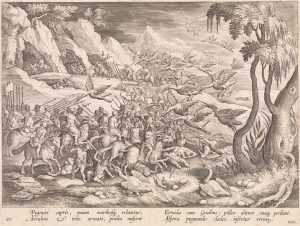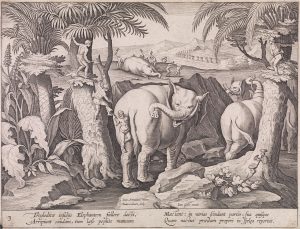Pygmies versing beasts according to Homer and Pliny
According to Homer, there existed a tribe of Pygmies, or diminutive people one-and-a-half feet tall, who were constantly at war with cranes (The Iliad book III). This Greek myth recounts how these Pygmies lived in caves and rode about on rams. Annually the tribe partook in a great war with the cranes, with the objective to steal and eat many crane eggs and chicks, thereby keeping the vicious crane population in check.

The Flemish artist Adriaen Collaert (c.1560-1618) illustrates this very event in his engraving, Fight between Pygmees and Cranes (c.1596) where we see the tribe gallop forth on their rams and billy goats, and a deadly skirmish between human and beast ensue. This plate is from the large series, Venationes, ferarum, arium, piscium (Hunts of wild animals, birds and fish). When the series was commissioned, hunting scenes were of great interest, for Jan van der Straet (1523- 1605) had just made drawings of hunting imagery for tapestries to decorate the Medici villa at Poggio a Caiano. The success of van der Straet’s scenes were the basis of this printing epic which was first published in 1596 and again in the following centuries. [1.]
Something rather curious takes place within the set of engravings, for Homer’s Pygmies seem to have found their way from one plate into another. In Cavemen chasing elephants, several tiny individuals, outfitted in the same garb as the Pygmies in plate 22 (hat and waistcloth), have launched an attack on some unsuspecting elephants.

In book eight of Pliny the Elder’s Natural History we read that: ‘The Cavemen on the frontier of Ethiopia, whose only food is elephant meat obtained by hunting, climb up trees near the elephants’ track and there keep a look out for the last of the whole column and jump down on to the hind part of its haunches’ [2.] A quote which is very aptly illustrated by the engraving. With the exception that the Ethiopians seem to have been depicted as Pygmies.
Homer’s tribe were said to live in Okeanos (Oceanus), a location sometimes interpreted as the Nile, Africa, where cranes migrate. The cranes ‘make for the rivers of Ocean to bring death and destruction to the Pygmies, launching their wicked assault from the air.’ [3.] So it seems that the writings of these two ancient authors, Homer and Pliny, were combined in the creation of these two engravings. Whether either literary source was based on factual evidence or fantasy concerning the existence of an ancient Pygmy tribe, the texts and the engraved series stimulates a hunger to learn more about exotic lands, people and animals.
Kerrianne Stone (Curator, Prints)
References
[1.] Joannes Stradanus and his Hunting Scenes
[2.] Pliny: Natural History, Plinii: Naturalis Historia, Liber VIII, Loeb Classics Library
[3.] The Iliad Homer; originally translated by E.V. Rieu; revised and updated by Peter Jones with D.C.H. Rieu; edited with an introduction and notes by Peter Jones, London Penguin Classics, 2014, p. 45
[…] continue their ongoing war with “pygmies”, after a nice long break from the violence. Pliny wrote that the “pygmies” would ride out on sheep to attack the cranes and eat their eggs, in […]
[…] Adriaen Collaert, d’après Jan van der Straet (c.1596). Merci https://blogs.unimelb.edu.au/librarycollections/2018/03/19/pygmies-versing-beasts-according-to-homer…. […]